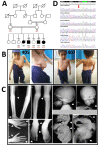A Stop-gain Variant c.220C>T (p.(Gln74*)) in FLNB Segregates with Spondylocarpotarsal Synostosis Syndrome in a Consanguineous Family
- PMID: 37781000
- PMCID: PMC10524816
- DOI: 10.59249/UTCP9818
A Stop-gain Variant c.220C>T (p.(Gln74*)) in FLNB Segregates with Spondylocarpotarsal Synostosis Syndrome in a Consanguineous Family
Abstract
Spondylocarpotarsal synostosis (SCT) syndrome is a very rare and severe form of skeletal dysplasia. The hallmark features of SCT are disproportionate short stature, scoliosis, fusion of carpal and tarsal bones, and clubfoot. Other common manifestations are cleft palate, conductive and sensorineural hearing loss, joint stiffness, and dental enamel hypoplasia. Homozygous variants in FLNB are known to cause SCT. This study was aimed to investigate the phenotypic and genetic basis of unique presentation of SCT syndrome segregating in a consanguineous Pakistani family. Three of the four affected siblings evaluated had severe short stature, short trunk, short neck, kyphoscoliosis, pectus carinatum, and winged scapula. The subjects had difficulty in walking and gait problems and complained of knee pain and backache. Roentgenographic examination of the eldest patient revealed gross anomalies in the axial skeleton including thoracolumbar and cervical fusion of ribs, severe kyphoscoliosis, thoracic and lumbar lordosis, coxa valga, fusion of certain carpals and tarsals, and clinodactyly. The patients had normal faces and lacked other typical features of SCT like cleft palate, conductive and sensorineural hearing loss, joint stiffness, and dental enamel hypoplasia. Whole exome sequencing (WES) of two affected siblings led to the discovery of a rare stop-gain variant c.220C>T (p.(Gln74*)) in exon 1 of the FLNB gene. The variant was homozygous and segregated with the malformation in this family. This study reports extensive phenotypic variability in SCT and expands the mutation spectrum of FLNB.
Keywords: carpal and tarsal fusion; coxa valga; kyphoscoliosis; lordosis; pectus carinatum; short stature; winged scapula.
Copyright ©2023, Yale Journal of Biology and Medicine.
Figures

Similar articles
-
Spondylocarpotarsal synostosis syndrome due to a novel loss of function FLNB variant: a case report.BMC Musculoskelet Disord. 2021 Jan 6;22(1):31. doi: 10.1186/s12891-020-03890-2. BMC Musculoskelet Disord. 2021. PMID: 33407338 Free PMC article.
-
Filamin B Loss-of-Function Mutation in Dimerization Domain Causes Autosomal-Recessive Spondylocarpotarsal Synostosis Syndrome with Rib Anomalies.Hum Mutat. 2017 May;38(5):540-547. doi: 10.1002/humu.23186. Epub 2017 Feb 27. Hum Mutat. 2017. PMID: 28145000
-
Seven additional families with spondylocarpotarsal synostosis syndrome with novel biallelic deleterious variants in FLNB.Clin Genet. 2018 Jul;94(1):159-164. doi: 10.1111/cge.13252. Epub 2018 Apr 14. Clin Genet. 2018. PMID: 29566257
-
Filamin B: The next hotspot in skeletal research?J Genet Genomics. 2017 Jul 20;44(7):335-342. doi: 10.1016/j.jgg.2017.04.007. Epub 2017 Jul 6. J Genet Genomics. 2017. PMID: 28739045 Review.
-
Spondylocarpotarsal synostosis syndrome (with or without unilateral unsegmented bar).Am J Med Genet. 1994 May 15;51(1):1-8. doi: 10.1002/ajmg.1320510102. Am J Med Genet. 1994. PMID: 8030662 Review.
References
-
- Marinakis NM, Svingou M, Veltra D, Kekou K, Sofocleous C, Tilemis FN, et al. Phenotype-driven variant filtration strategy in exome sequencing toward a high diagnostic yield and identification of 85 novel variants in 400 patients with rare Mendelian disorders. Am J Med Genet A. 2021. Aug;185(8):2561–71. 10.1002/ajmg.a.62338 - DOI - PubMed
-
- Negri G, Magini P, Milani D, Crippa M, Biamino E, Piccione M, et al. Exploring by whole exome sequencing patients with initial diagnosis of Rubinstein-Taybi syndrome: the interconnections of epigenetic machinery disorders. Hum Genet. 2019. Mar;138(3):257–69. 10.1007/s00439-019-01985-y - DOI - PMC - PubMed
Publication types
MeSH terms
Substances
Supplementary concepts
LinkOut - more resources
Full Text Sources
Medical
Miscellaneous
